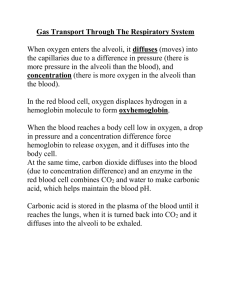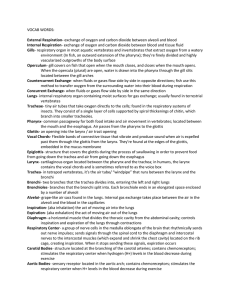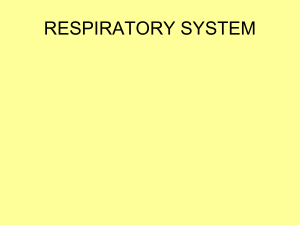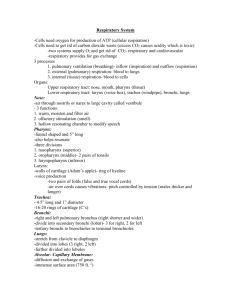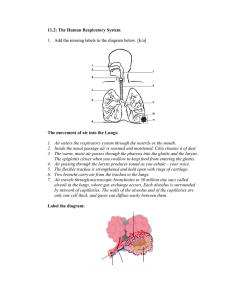Document 15362497
advertisement
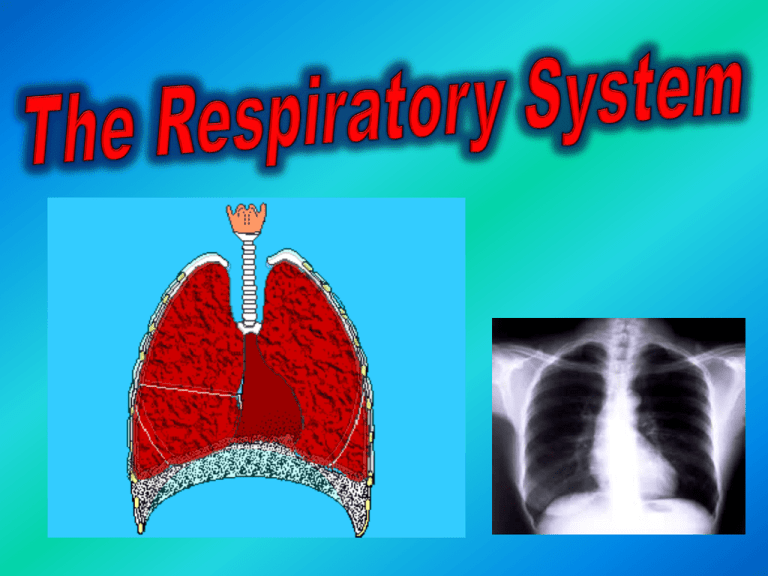
1. Identify and give the functions for each of the following: Larynx,Trachea, Bronchi, Bronchioles, Alveoli, Diaphragm & ribs, Pleural membranes, and Thoracic cavity. 2. Compare and contrast the mechanics of the processes of inhalation and exhalation . 3. Explain the relationship between the structure and function of the alveoli. 4. Explain the roles of the cilia and mucous in the respiratory tract. 5. Describe the interaction of the lungs, pleural membranes, ribs, and diaphragm in the breathing process. 6. Explain the roles of carbon dioxide and hydrogen ions in stimulating the breathing centre in the medulla oblongata. 7. Describe the exchange of carbon dioxide and oxygen during internal and external respiration. 8. Distinguish between the transport of carbon dioxide and oxygen in the blood by explaining the roles of oxyhemoglobin, carboxyhemoglobin, reduced hemoglobin, and bicarbonate ions. _____ Alveoli _____ Bicarbonate ions _____ Breathing _____ Bronchi _____ Bronchioles _____ Carbaminohemoglobin(HbCO2) _____ Carbon dioxide _____ Carbonic anhydrase _____ Carboxyhemoglobin (HbCO2) _____ Cartilage _____ Cellular respiration _____ Chemoreceptors _____ Cilia _____ Diaphragm _____ Epiglottis _____ Esophagus _____ Exhalation/Expiration _____ External respiration _____ Hemoglobin _____ Hydrogen ions _____ Inspiration/Inhalation _____ Intercostal muscles _____ Internal respiration _____ Larynx _____ Lipoproteins (surfactant) _____ Medulla oblongata _____ Mucous _____ Nasal sinus _____ Nose hairs _____ Oxyhemoglobin (HbO2) _____ Pharynx _____ Pleural membrane _____ Pneumothorax _____ Pulmonary capillaries _____ Reduced hemoglobin (HHb) _____ Sinus _____ Stretch receptors _____ Surface tension _____ Thoracic cavity _____ Trachea _____ Vocal cords The right lung is slightly larger than the left. Hairs in the nose help to clean the air we breathe, as well as warming it. The highest recorded "sneeze speed" is 165 km per hour. The surface area of the lungs is roughly the same size as a tennis court. Each red blood cell has about 200250 million Hemoglobin molecules. The capillaries in the lungs would extend 1,600 km if placed end to end. We lose half a litre of water a day through breathing. This is the water vapour we see when we breathe onto glass. A person at rest usually breathes between 12 and 15 times a minute. The breathing rate is faster in children and women than in men. Lung breathing probably evolved about 400 million years ago. Part of Respiratory system http://video.about.com/ lungdiseases/HowLungs-Function.htm The Nasal Sinus is surrounded by a lot of capillary beds and mucous glands. Because it is one of the major entry ways into the body it has many things to help keep us safe 1. Nose hairs: with the aid of mucous, these hairs filter and trap debris. The debris that is trapped in this manner is discharged through the nose. 2. There are many white blood cells here to recognize and destroy foreign objects. 3. Histamines are released here as an allergic response when foreign irritants are encountered. This causes runny nose. This is the common passageway for air and food This is a flap of tissue that covers the top of the trachea when swallowing to ensure that food enters the esophagus and not the lungs. When the epiglottis is opened, the air is able to pass through the larynx (voice box) and into the trachea. The larynx contains the vocal cords (two tendons that adjust the pitch of sounds according to how taut they are). When a guy goes through puberty, his vocal chords and voice box (larynx) grow larger, and begins to stick out at the front of the throat. This lump is called the Adam's Apple. Male vocal cords: 17 mm & 25 mm in length. Female vocal cords: 12.5 mm & 17.5 mm [1 in length. This is the windpipe. This passageway is held open by the presence of C-shaped rings of cartilage. This is a protective adaptation. The trachea conducts air into the bronchi. •Cilia and mucus filter the air as it moves through the trachea. •The mucous traps the dirt and other particles, and the cilia push it to the back of the throat so we swallow it into our digestive system Cilia with pollen trapped by mucous. The trachea splits into two bronchi and takes the air into each lung. These branches also have cartilage around them, for the same reason. The bronchi conducts air into smaller branching passageways called bronchioles. The bronchioles are branching passageways that carry air to its ultimate destination, the alveoli. Several things happen to the air on its way to the alveoli. It is: 1. Adjusted to Body Temperature: By the time it arrives at the alveoli the air has been in contact with many tissues and is 37o C. 2. Adjusted to 100% humidity. As inhaled air passes over the mucous passageways, it becomes saturated with water. 3. Cleansed of debris in a 2 part process. 1. Nose hairs and mucous in the nasal passageways. 2. Mucous and Cilia in Trachea and bronchi. *Note: cilia do not filter! These are the blind sac-like endings at the end of the bronchioles. There are approx. 700,000 alveoli in the human lung. This is the site of gas exchange. O2 leaves the alveoli and moves into the blood to be taken around the body. CO2 does the opposite and is breathed out. Why are they so special? 1. NUMEROUS: Each adult lung contains millions of alveoli. This provides lots of surface area for the gases to be exchanged. 2. THIN WALLS: The walls of alveoli are only one cell thick. 3. STRETCH RECEPTORS: They have stretch receptors that signal when the alveoli are full enough (stretched). They send a message to the brain to start exhalation. Why are they so special? 4. MOIST: They are very moist and this helps gas exchange. 5. VERY RICH BLOOD SUPPLY: They have a close association with many blood capillaries so oxygen and carbon dioxide can be exchanged efficiently. 6. LINED WITH A LAYER OF LIPOPROTEINS (surfactant) on their inner surface. This helps to maintain surface tension, thus preventing them from collapsing and sticking together during exhalation. This is a sheet of muscle that separates the chest cavity from the abdominal cavity. When you inhale it moves down. When you exhale it moves up. These are the bones that are connected to the vertebral column and sternum. These are INTERCOSTAL muscles between the ribs, which help to move the ribs… 1.Up and out when we inhale. 2.Down and in when we exhale. Our control of the breathing process is only voluntary to a point. The medulla oblongata of the brain is sensitive to the concentration of carbon dioxide and hydrogen ions in the blood. When the concentrations of H+ and CO2 reach a critical level, the breathing center in the medulla oblongata is stimulated and sends nerve impulses to the diaphragm and the intercostal muscles. When the brain realizes there is too much CO2 in our blood, it sends a message to the rib muscles and diaphragm to contract. The ribs move up and out, the diaphragm moves down. This creates more space in the lungs (negative air pressure) and air rushes in to fill that space. This is called inhalation. When the alveoli get too stretched (full of air), they send a message to the brain to stop inhaling. The brain tells the muscles to relax and the ribs move back down and in, while the diaphragm moves back up. This decreases the amount of space in the lungs and the air is pushed out. This is called exhalation. See a Working Respiratory System: http://www.smm.org/heart/ lungs/breathing.htm These are membranes that enclose the lungs. The outer pleural membrane sticks closely to the walls of the chest & the diaphragm. The inner pleural membrane is stuck to the lungs. The two lie very close to each other. The pleura allows the surface of the lungs to slide over the body wall easily, without abrasion. The pleura seals off the thoracic cavity so when the lungs inflate, a negative air pressure is created and this causes air to rush in. These membranes also stick the lungs to the chest cavity walls, so when the ribs move out, so do the lungs. A puncture to the chest wall, piercing the pleural membrane (even without damaging the lung itself), will result in a pneumothorax, or collapse of the lung. In a situation like this, the negative pressure effectively draws air in through the puncture wound, putting pressure on the surface of the lung instead of inside it and the lung collapses. Respiration is the set of processes involved with the conduction of oxygen to the tissues and the removal of the waste product CO2. There are four aspects to respiration: 1. Breathing: the inspiration and expiration of air. 2. External Respiration: gas exchange at the alveoli. 3. Internal Respiration: gas exchange at the tissues. 4. Cellular Respiration: mitochondria turn O2 and glucose into CO2 and H2O and ATP energy. Happens at the lungs. It is the diffusion of O2 into the pulmonary capillaries (blood) and the diffusion of CO2 and water into the alveoli to be exhaled with the air. Because there is a lot of CO2 returning to the lungs, and not very much in the alveoli, the CO2 diffuses from [H] to [L] down its concentration gradient and moves into the alveoli to be breathed out. Because there is a lot of O2 in the fresh air in the alveoli, and not much in the deO2 blood, the oxygen diffuses from [H] to [L] down its concentration gradient and into the blood. Conditions in the blood at the alveoli are: Basic: pH of ~7.4 Cool: ~37o C Low (negative) pressure Under these conditions, hemoglobin lets go of CO2 and starts to love oxygen. As it leaves the lungs, 99% of hemoglobin is occupied with oxygen it is called oxyhemoglobin. O2 + Hb HbO2 Hemoglobin transports oxygen to the tissue cells. Happens at the tissues. It is the diffusion of O2 into the tissue cells, and the diffusion of CO2 and water into the blood capillaries. The CO2 is then returned to the heart and sent to the lungs to be removed during exhalation. O2 CO2 Conditions in the blood at the tissues are: Acidic: pH of ~7.3 Warm: ~38o C High pressure Under these conditions, hemoglobin lets go of O2 and starts to love CO2 and H+. HbO Hb + O 2 2 The oxygen diffuses into the tissue spaces along with the water that is forced from the plasma due to blood pressure. CO2 + H2O + O2 + GLUCOSE At the venule end of the capillary bed, when water is drawn back into the blood by osmotic pressure, CO2 enters the blood. Carbon dioxide can be transported in three ways: 1. Dissolved gas, 2. Carboxyhemoglobin (HbCO2), 3. Bicarbonate ion (HCO3-) Because the hemoglobin now loves the CO2, they join to form carboxyhemoglobin. CO2 + Hb HbCO2 CO2 also joins with water to make the bicarbonate ion. There is an enzyme in the red blood cells called CARBONIC ANHYDRASE which catalyzes this reaction. CO2 + H2O HCO3- H2CO3 Carbonic anhydrase Carbonic anhydrase + H+ CO2 + H2O Carbonic anhydrase The extra hydrogen ion from the water is now free. This is BAD as it is ACIDIC and can eat through the blood vessel walls. So, hemoglobin acts as a buffer and joins with the hydrogen ion to make reduced hemoglobin. H+ + Hb HCO3- H2CO3 HHb Carbonic anhydrase + H+ When the blood returns to the lungs, the conditions change again, and hemoglobin dumps CO2 and H+ & wants to pick up O2 again. So all of the reactions happen in reverse. HbCO2 HHb H+ CO2 + Hb H+ + Hb + HCO3- H2CO3 Carbonic anhydrase CO2 + H2O Carbonic anhydrase At this point, all that is left to be excreted at the lungs is water and CO2. So the CO2 diffuses into the alveoli and is exhaled. The water will either: 1. Be exhaled in the air 2. Enter the alveoli to keep them moist 3. Remain in the plasma H2O + CO2 Gas Exchange • Partial Pressure – Each gas in atmosphere contributes to the entire atmospheric pressure, denoted as P • Gases in liquid – Gas enters liquid and dissolves in proportion to its partial pressure • O2 and CO2 Exchange by DIFFUSION – PO2 is 105 mmHg in alveoli and 40 in alveolar capillaries – PCO2 is 45 in alveolar capillaries and 40 in alveoli Partial Pressures • Oxygen is 21% of atmosphere • 760 mmHg x .21 = 160 mmHg PO2 • This mixes with “old” air already in alveolus to arrive at PO2 of 105 mmHg • Carbon dioxide is .04% of atmosphere • 760 mmHg x .0004 = .3 mm Hg PCO2 • This mixes with high CO2 levels from residual volume in the alveoli to arrive at PCO2 of 40 mmHg Gas Exchange Between the Blood and Alveoli Gas Exchange Between the Blood and Alveoli Volume (ml) Measurement of Lung Capacity Measurement of Lung Capacity Lung volumes and vital capacity Total Lung Volume: (~6000ml) Measurement: Spirometer Tidal Volume (~500 ml): Volume of air inhaled and exhaled in a single breath Inspiratory Reserve Volume (~3100 ml): The amount of air that can be inhaled beyond the tidal volume Expiratory reserve volume (~1200 ml): the amount of air that can be forcibly exhaled beyond the tidal volume Measurement of Lung Capacity Vital Capacity (~4800 ml): The maximal volume that can be exhaled after maximal inhalation Vital Capacity = Tidal volume+IRV+ERV Residual volume (~1200 ml): the amount of air remaining in the lungs, even after a forceful maximal expiration Dead Space Volume: The air that remains in the airways and does not participate in gas exchange •Smoking causes lung cancer and emphysema •Emphysema causes the alveoli to lose their elasticity •People who have respiratory disease often have heart disease •There are over 4000 chemicals in cigarettes •Smoking also destroys the cilia lining in your respiratory system so that dirt and particles can’t be removed
